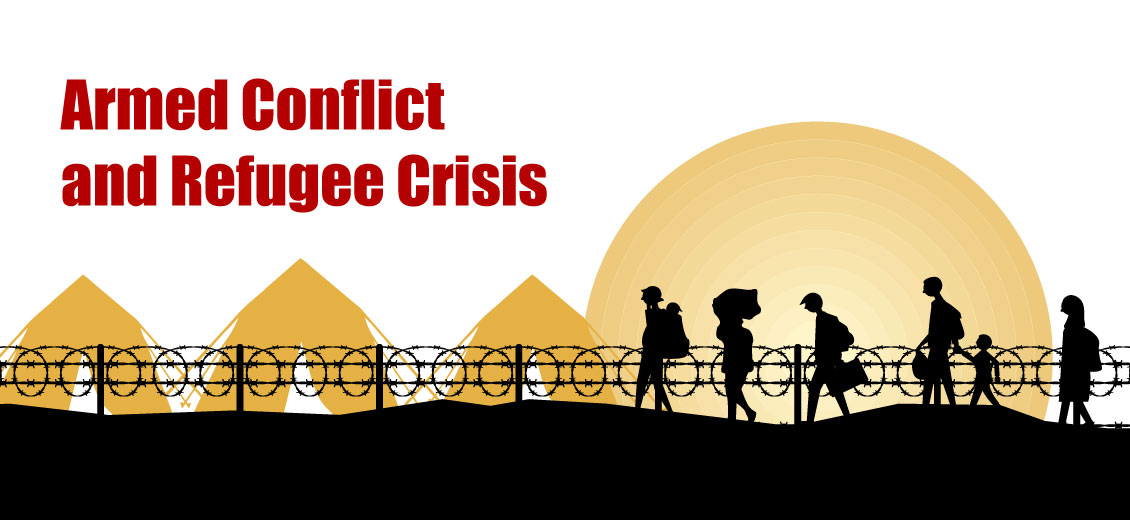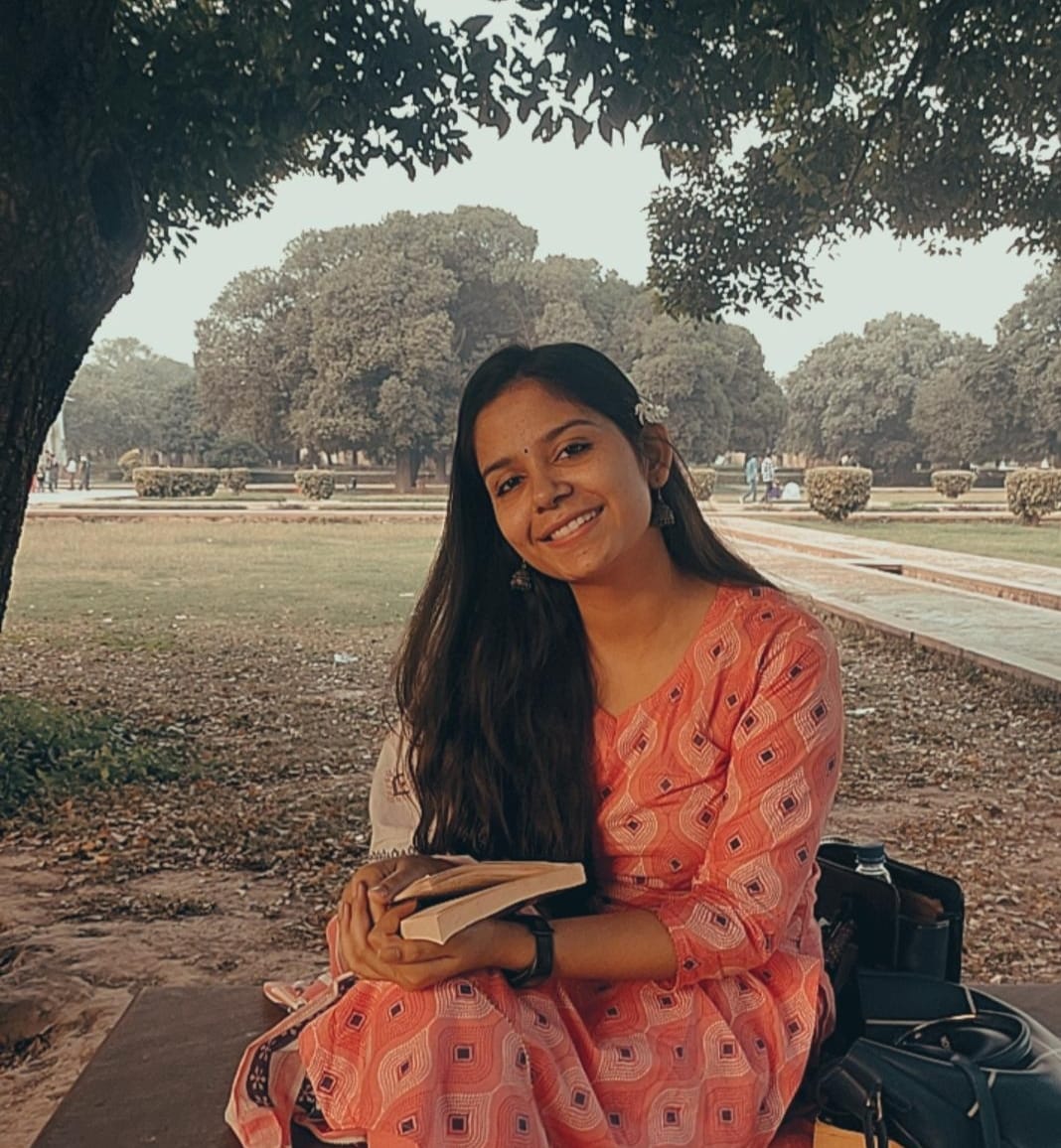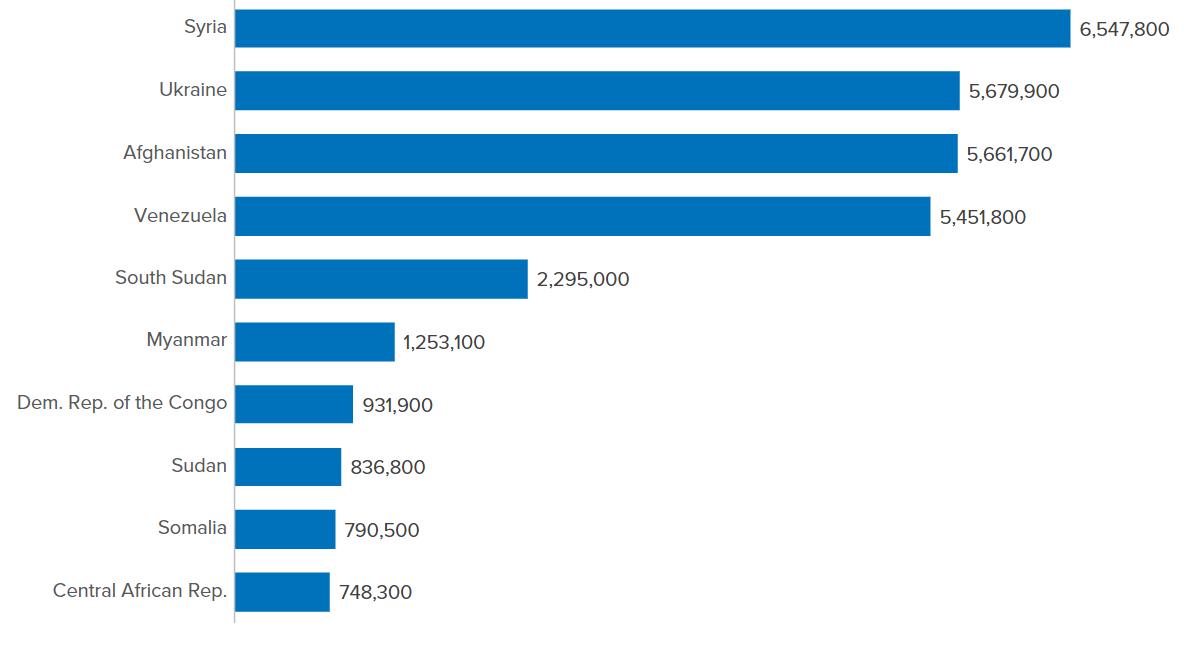Armed Conflict and Refugee Crisis
Blogs Home
- 20 Jun 2023

Armed conflicts are defined as political or state-based conflicts which constitute the use of armed force by two parties of which at least one is the government of a state. They are ‘contested incompatibility’, where at least 25 battle-related deaths take place in one calendar year. A ‘major armed conflict’ is a war between states in which armed fighting or clashes between government forces and its opponents result in at least 1,000 deaths in the course of the conflict.
The Uppsala Conflict Data Program (UCDP) differentiates armed, state-based conflicts as,
- Intrastate/civil conflict: This refers to violence between a government and at least one non-governmental party within a sovereign country.
- Interstate conflict: This refers to violence between two or more governments.
The primary causes of armed conflicts, include the inability of governments to provide basic protection and governance to their citizens, the struggle for power by an excluded section of the society in authoritarian systems of one-party rule, unequal treatment and access to political power based on ethnicity, religion, national identity or economic class, economic decline and mismanagement, radical market-oriented economic reforms, and structural adjustment imposed without compensating social policies, mass violations of human and minority rights, ethnic cleansing, and wide availability of weapons, etc. Consequently, societies affected by armed conflicts have bore the brunt of violence resulting in large numbers of displacement, mortality, and economic, political, and social disintegration. For example, the fall of the Berlin Wall led to the killing of nearly four million people in violent conflicts. Women and children, in particular, suffer starvation, disease, sexual exploitation, insecurity, and trauma, while countless others are forced to witness or even take part in horrifying acts of violence leading to intense psychological trauma. It has been observed ( see figure no. 1) that interstate conflicts have rarely occurred since the end of WWII in contrast to internal conflicts which are much more common.
Figure 1: Shows the number of Interstate and Intrastate conflicts between 1945 to 2015.
In addition, there also has been a trend of two other types of political conflicts: non-state conflict and one-sided violence. While non-state conflict includes violence involving only non-state actors, like riots and communal conflicts, whereas one-sided violence details killings by an armed organization of unarmed victims, involving states or non-state actors. According to Uppsala Conflict Data Program (UCDP) data covering the years from 1985 to 2020, figure 2 demonstrates how non-state conflict has increased considerably. As opposed to non-state conflicts, one-sided violence appears more stable with a slight increase since 2009.
Figure 2: The frequency of non-state conflicts and instances of one-sided violence.
The States parties to the 1949 Geneva Conventions have assigned the International Committee of the Red Cross (ICRC) "to work for the understanding and dissemination of knowledge of International Humanitarian Law applicable in armed conflicts and to prepare any development thereof”. International Humanitarian Law (IHL) also known as "the law of war" or "the law of armed conflict", is a set of rules that seeks to limit the effects of armed conflict for humanitarian reasons. It aims to protect people who are not or are no longer, directly or actively participating in conflicts and assesses limits on the means and methods of warfare.
IHL classifies the conduct of hostilities based on three core principles: distinction, proportionality, and precaution. While the principle of distinction requires the parties to an armed conflict to distinguish between civilians and combatants to aim the attacks only against military objectives and combatants, the principle of proportionality states, when attacking for a military purpose, incidental loss, injury, or damage to civilian life or objects must not be excessive as compared to the anticipated ‘direct military advantage’. The principle of precaution suggests “active precautions” and “passive precautions” to spare the civilian population and civilian objects in each military operation. IHL manages a range of issues, including protection for sick, wounded, and shipwrecked members of the armed forces, treatment of prisoners of war and other persons captured in connection with armed conflicts, protection for the civilian population and objects, and restrictions on the use of certain weapons and methods of warfare.
To promote and enforce the IHL, International conventions and organizations such as the Geneva Conventions and Additional Protocols have established the legal framework for IHL, entailing protection of medical personnel, treatment during the conflict, and humane treatment of prisoners. While the International Committee of the Red Cross (ICRC) directly works with concerned parties in order to ensure compliance with IHL and provides help to victims, the United Nations (UN) through its Security Council, General Assembly, and Human Rights Council addresses violations and the International Criminal Court (ICC) prosecutes severe crimes. International and local NGOs also contribute by advocating for accountability and raising awareness.
The 1951 Refugee Convention defines a refugee as “someone who is unable or unwilling to return to their country of origin owing to a well-founded fear of being persecuted for reasons of race, religion, nationality, membership of a particular social group, or political opinion.” There are different types of refugees, for instance, Asylum Seekers, Internally displaced persons, stateless persons, Religion or political affiliation refugees, Hunger refugees, War refugees, climate change refugees, and refugees of gendered violence. Refugee crisis are driven by factors such as armed conflicts, political instability, environmental crisis, and economic factors due to which people flee in search of safety and better opportunities. This displacement leads to the loss of homes, livelihoods, and communities. Socioeconomic impacts affect both hosts and refugees, with limited access to employment, healthcare, and education, along with increased competition. However, the existence of certain international legal frameworks such as the 1951 Refugee Convention defines the rights and obligations of refugees, while the UNHCR is entrusted with their protection. In addition, the 1967 Protocol expanded the Convention's scope highlighting that people displaced before 1951 or outside of Europe are also eligible for protection under the Convention. The UNHCR advocates for refugee rights, offers assistance, and seeks durable solutions, in this regional instruments also supplement the global efforts.
According to the UNHCR's Global Trends Report 2022, 108.4 million worldwide people at the end of 2022 were forcibly displaced as a result of persecution, conflict, violence, human rights violations, and events seriously disturbing public order. Syrians accounted for almost 1 in 5 refugees globally, with 6.5 million hosted in 131 countries. While the number of Ukrainian refugees increased from 27,300 at the end of 2021 to 5.7 million at the end of 2022 and Afghan refugees and people in refugee-like situations increased by 2.9 million to 5.7 million.
Figure 3: Refugees, people in refugee-like situations, and other people in need of international protection by the country of origin | end-2022
However, an effective partnership between the UN Secretariat, the Security Council, and the countries made it possible for 55 peacekeeping operations around the world to complete their mandate. One such example is the deployment of the UN Mission in Liberia, where more than 100,000 former combatants engaged in demobilization, disarmament, and reintegration programs, leading to the re-establishment of the armed forces and police. Regional organizations like the European Union (EU) and African Union (AU) support UN efforts, making use of their regional expertise and networks. However, the UN has been unsuccessful in certain missions as well. For example, in 1994 the United Nations Assistance Mission for Rwanda (UNAMIR) was unable to prevent the genocide that unfolded in the nation as a consequence of an armed conflict between two groups. The mission faced constraints in its mandate, lacked sufficient resources, and proved inadequate in stopping the mass killings, resulting in significant deaths including the Prime Minister, cabinet ministers, and UNAMIR peacekeepers who were among the first victims.
Coming to the Indian context, the economic development of India has been remarkable in the last three decades, a few major armed conflicts have presented a huge challenge to the unity and development of the country on an international level. The Indian subcontinent has witnessed a long history of armed conflicts and refugee crisis pre and post-independence including the nationalist movement, Khalistan movement, Kashmir conflict, Naxalite/Maoist Insurgency, and Mizoram Insurgency as a result of ethno-nationalist aspirations, socio-economic-disparities, and ideological differences. One such conflict, the Naxalite/Maoist insurgency in central and eastern India has its origins in the Naxalbari uprising of the spring of 1967 and seeks to address social inequality and land rights through armed struggle. Long-standing insurgencies have been faced by northeastern states like Manipur, Assam, and Nagaland fueled by demands for autonomy, secession, and ethnic tensions, and have resulted in deaths, displacement, and economic instability. The Ministry of Home Affairs revealed in its 2019 report that approximately 417 civilians have been killed per year in approximately 1,200 violent incidents initiated by Maoists, since 2010. In addition, the National Crime Records Bureau in 2021, shared a report concerning crimes by North-East Insurgents in which 151 people were booked under the Unlawful Activities (P) Act, 1967 of which 6 belonged to Meghalaya, 8 to Assam, and 136 to Manipur. As per the Indian government deployment of security forces, initiation of peace talks, and implementation of development programs have been done however establishing peace and mutual trust has remained a complex issue in the northeast of India.
The role of security forces such as the Central Reserve Police Force (CRPF), state police, and paramilitary forces have been significant in maintaining law and order in these regions while government policies such as Integrated Action Plan (IAP), Security-Development Nexus, and Surrender-Cum-Rehabilitation policies have been crucial in addressing the issue. However, these policies have received criticism for overlooking the root causes of conflict such as socio-economic inequalities, governance issues, and land rights. In addition, concerns are raised against excessive use of force by security forces and abuse of human rights allegations have created a need for a more holistic approach that integrates respect for human rights, political dialogue, and socio-economic and political development.
Amidst these concerns, the complex relationship between armed conflict and terrorism is of great relevance. While certain armed conflicts have been fostered by terrorist organizations, not all armed conflicts involve terrorism. Terrorism often emerges as a method used by non-state actors in an armed conflict to fulfill their respective ideological, political, or religious ambitions by deliberately targeting non-combatants and civilians.
In this light, Transnational terrorism emerges as a significant threat to global peace and security. Extremist organizations like ISIS and Al-Qaeda have attacked multiple nations, including India, and have destabilized regions presenting a challenge to international and national security. The widespread perpetuation of extremist ideologies, training of foreign and local militants, as well as cross-border attacks are some of the pressing dangers born as a consequence of transnational terrorism. To counter terrorism, nations across the globe have implemented multiple policies and formed alliances, and strategies including sharing intelligence, border controls, law enforcement cooperation, financial regulations, and military interventions. Strategies like United Nations Global Counter-Terrorism aims to build international cooperation and coordination in combating terrorist organizations. The UN Global Counter-Terrorism Strategy is reviewed by UN General Assembly every two years, thus making it a living document receptive towards Member States’ counter-terrorism priorities. After the recent occupation by the Taliban in Afghanistan, new internal displacements amounting to 777,400 in 2021 took place as a result of increasing instability and violence. The impact of this occupation has been severe particularly on women and children as 80 percent of newly displaced Afghans are women and children. Nearly 23 million people, or more than half of Afghanistan’s population, suffer from acute hunger, while the fundamental rights of women and children are under threat. As a result, countries like Pakistan and Iran continue to host more than 1.3 million and 780,000 registered Afghan refugees respectively.
Consequently, it is crucial to formulate strategies for conflict resolution and peacebuilding that includes various concrete methods such as mediation, negotiation, and reconciliation. For instance, mediation by the United States in the peace process between Israel and Egypt paved the way for the 1978 Camp David Accords, establishing peace between the two nations. Reconciliation efforts in South Africa, exemplified by the Truth and Reconciliation Commission, aimed at healing societal divisions between racial and ethnic groups during the period of apartheid. However, there exist challenges and processes of post-conflict reconstruction and rehabilitation including what UNDP suggests as the ‘easing of hostilities and violence, signing of peace agreements, demobilization, disarmament and reintegration, return of refugees and internally displaced persons, establishing the foundation for a functioning state, initiating reconciliation and societal integration, and commencing economic recovery’.
Therefore, there is a critical need for active participation of the local population to ensure accountability in resource allocation, effective coordination among donor countries and aid organizations for efficient resource utilization, and a comprehensive regional approach to make sure that reconstruction efforts address not only the conflict-affected area but also the wider impact on neighboring countries, fostering stability and resilience in the entire region, reducing poverty in former conflict zones, boosting security in poor countries, seeking advice and support for the police and judiciary in other countries to reduce crime, improve living conditions in overcrowded prisons and reduce the incidence of violence against marginalized and establishing stability fund.
References:
https://www.unhcr.org/global-trends-report-2022
https://peri.umass.edu/media/k2/attachments/WP405.pdf
https://www.un.org/counterterrorism/un-global-counter-terrorism-strategy
https://ncrb.gov.in/sites/default/files/CII-2021/TABLE%2010B.1.pdf
https://unmil.unmissions.org/unmil-completes-its-mandate-now-peaceful-liberia
https://www.government.nl/topics/international-peace-and-security/post-conflict-reconstruction
https://peacekeeping.un.org/en/mission/past/unamirS.htm
https://www.un.org/en/global-issues/international-law-and-justice
What is International Humanitarian Law?
Global Conflict Trends and their Consequences* - the United Nations
Armed conflicts and their consequences - the United Nations
The Story of UNMIL - UN missions
https://www.pcr.uu.se/research/ucdp/definitions#tocjump_9688779482412024_2
https://www.unrefugees.org/news/afghanistan-refugee-crisis-explained/
Maitri Singh

Maitri Singh is a post-graduate in English Literature from Ambedkar University, Delhi. Backed with her minor in Political science, she often delves into the matters concerning politics and history with a keen eye. Her interests also lie in Social work and Translation studies.
Blogs Home






